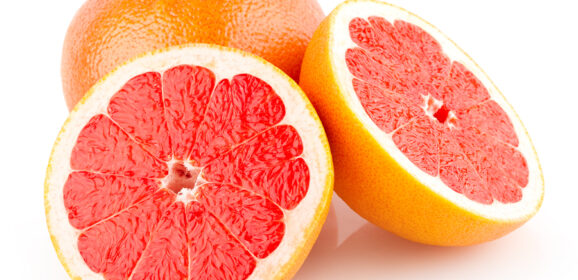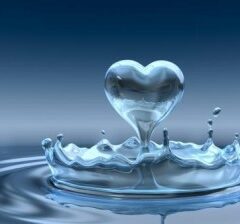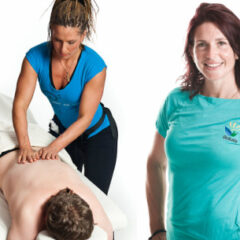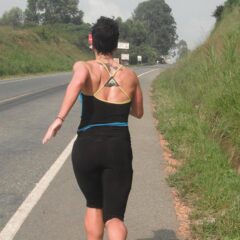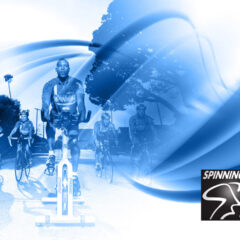Water, source of life; Do you drink enough?
It is possible to live without light, like few organisms do deep down into the sea, but no living entity can live without water. Water is the strength behind creation of life, according to Masaru Emoto, Japanese author known for his researches on the powerful effect of thoughts and emotions on water molecules. For instance, if you have 2 identical glasses of water and you place one under classical music or words of love, and the other under very aggressive music, the esthetics of the water molecules’ crystals change drastically in 2 different ways. It is actually a proven fascinating theory that I strongly suggest you read about, if it’s not done already. It is therefore possible that water has a healing effect on us if we put the right intention to it, by drinking it or bathe in it, as incredible as this may seem! Let’s not forget that our body is composed with 70% of water. Water carries substances to maintain life, it keeps our body temperature viable and allows chemical reactions within our cells. Drinking enough water will keep your muscles supple, maintain an efficient blood circulation and a good functioning of the cells, including the neurologic activity in the brain. Water is necessary for all organs to allow an effective evacuation of toxins and other wastes. Being well hydrated will also keep the necessary amount of liquid in the synovial fluids, which is an efficient way to help prevent arthritis. Overall, drinking enough water is a true aspect of disease prevention, and we need more when we’re fighting most diseases. We eliminate daily about 2.5 liters of water through urine, stool, saliva, sweat, and vapor from lungs. People who have to talk a lot or sing, moms who breast-feed and of course athletes, lose more, so they have to drink more. When the body lacks water, it has to provide itself in extracellular fluids and we want to avoid that to stay healthy! How to know if we drink enough water? First, know that if you feel thirsty you are already dehydrated. It is essential to drink at least 1.5 liters of water daily, or 6 to 8 glasses. During a training session, you have to add ½ to 1 extra liter of water per hour of exercise. The best indicator of a good hydration remains to keep track of your urine color; if it’s dark you need to drink more, it’s as simple as that! If you don’t drink water or you claim to not like the taste, it’s really a question of habit. Water has no taste so you can’t realistically not like...
Running and posture!
Posture in running is a very important aspect to keep on adding miles as we get older, to lower the risks of injuries and to improve your performances. For instance, opening the rib cage and letting more air filling the lungs will feed more oxygen to the muscles through blood. Posture while running will also reflect on our every day usual posture, so we might as well make the following good habits now to avoid ending up with shoulders curving in, round back, head too far forward, hip misalignment or lumbar pain… Here are some important tips to apply for an optimal running posture: Stretch the spine up, keep your head straight and open the rib cage and chest, shoulders back and relaxed. You can always keep a little contraction of the rhomboids (muscle that keeps your shoulder blades together towards the spine) to strengthen your back and posture and create maximum space for your lungs… Not so easy to be conscious of these details at first but the more you remind yourself and apply it, the more it becomes an automatic habit, and that’s what we’re aiming for. You should also keep the hips aligned (not tilted forward or back, so no exagerated lumbar curve either) along with the trunk and head. Abdominals have to remain solid, unless you are still not used with the breathing, in which case you want to prioritize breathing through the belly, keep calm, and eventually develop the capacity to do so while keeping your abs tight, as if you were getting ready to protect yourself to receive a light punch in the stomach, staying tall. Each step movement has to start from the core including hips and abdominals, arms stay loose (while shoulders are rolled back) with the upper body slightly forward to help yourself run using gravity. It is important to never land on your heels first, the continuous impact would damage your articulations in no time. Instead, think of absoprtion and expulsion on each step by landing on the middle of your foot and pushing from its balls, making your body look light. Whether you are new in this wonderful sport or you have done 15 marathons already, make sure your technique is optimal and be conscious of your posture, your body will thank you! Soon to come, plenty more tricks and exercises to run better! For the joy of running, Annie...
Fabulous bananas!
Not only do they taste delicious, bananas are incredibly nutritious. They are the perfect healthy snack to calm a sweet tooth and help to regulate apetite for the next meal, they are good for bowel regularity and satiety, therefore can help one reach weight-loss goals, so keep them close and available. Averaging 90 calories per unit, they are rich in fibers, glucids, proteins, and contains electrolytes. Their high levels of potassium help to keep regular heart contractions and also replaces sweat losses while its magnesium is necessary for the body to change fuels from food into energy. This makes bananas an excellent food for athletes and active people, before and after activity. The role of manganese in bone development and good eyesight also makes the bananas a real kids’friend, and we can mash them with warm milk for younger babies when they start eating solids. Potassium also prevents hypertension and helps a good functioning of the nervous system and the brain. There is no question that bananas are a huge source of energy. Surprisingly they also are a natural soft sedative and an ideal snack before bed! That’s from the action of an aminoacid called tryptophan, which also has an impact on serotonine, the happy mood hormone! Eating bananas regularly even could help in several depression cases, anxiety, PMS syndrom and coping with stress. Constipation? Have an overripe banana, it becomes slightly laxative at that stage! Moreover, bananas have antibiotic properties. They are alcaline and offer a protection for our digestive system, prevent ulcers and strengthen the mucosa. Some studies also showed that they reduce the risk of kidney and colorectal cancer. To maximize bananas’ benefits, they have to be eaten ripe. The process can be accelerated by storing bananas in a paper bag with an apple, for instance. For the adepts of the plantain bananas, these have the same benefits, and some nutrients are even in bigger quantities! So what are you waiting for, go get these bananas! Your body will be grateful for this quality food. Bon apétit 😉 Annie Cap...
Kinesitherapy and Orthotherapy, what is it?
We often hear those terms without really knowing what it is… First, they both include massage therapy, mostly swedish, this manual technique that relaxes, improves circulation, helps toxins release, reduces inflammation, helps stress management and provides a feeling of wellbeing, amongst many more benefits. A kinsitherapist and an orthotherapist both have their full studies in massage therapy by definition. Kinesitherapy is a therapy by movements, it is a therapeutic approach that asembles all pathologies together in one hollistic system where the whole musculo-skeletal chain is taken into account. The objective of this technique is to gain back the normal mobility of a joint and reduce or stop pain around it. Its treatment includes a postural evaluation with some specific tests and palpations, followed by the therapeutic massage. This process often includes tools like essential oils, rubefacient cream and heat. Adapted mobilisations are an important asset to fix the problem, and a session always ends with some advices to follow such as muscular reinforcement, stretchings, nutrition, and more. Orthotherapy is even more forward-thinking and complete. Its goal is to relieve all kinds of muscular stiffness and lack of mobility, often linked to lack of exercise, continuous bad positioning at work, posture misalignment, repetitive or abrupt movements, etc. This approach works by softening muscles, realign the body in its normal axis, get strength in the proper muscles, stretch others and gain back normal amplitude in all movements. It includes deep-layers muscular massage (swedish base), kinesitherapy and mecanotherapy (including isometry, vertebrotherapy, myofacial stretchings and posturology). It reaches the third layer of muscles, these small ones that often play the biggest role in the mobility of articulations. Orthotherapy can be surprinsingly efficient for lumbar pain, cervicalgy, migrains, sciatic and other nerves issues, all kinds of back pain, hip pain, tendinitus and a full range of more pathologies, chronic or not. My philosophy is that if you do not see changes or if your discomfort has not gone away after 6 sessions, in any kind of therapy, change therapist! Orthotherapy or not, treatments shouldn’t take that long for results, usually one or two will be enough, with few exceptions. There are so many forms of therapies out there, the hardest part is to find the one that will suits you best. Orthotherapy (as well as massage therapy and kinesitherapy) works in pair with the execution of advices that will be given to you. Of course, prevention is the key, so monthly sessions will be very efficient to avoid reccurence. Ideal option is to gift yourself with this moment of apreciation and feel amazing benefits right after each treatment and growing sense of wellbeing over time. A therapeutic session can be very painful at times if there is a need to work on specific tensions, but...
Lactic acid and muscle stiffness
Lactic acid is a big organic molecule that is created when glucose is broken down to produce energy without oxygen. It is mainly a muscular metabolic waste but it can also be found in milk products, wine and few lacto-fermented vegetables. Muscles need energy to move and function. To produce contractions they need oxygen. If there is enough oxygen there will be very few wastes, but if there is not enough oxygen brought in the muscle there will be lactic acid created from the energy production. The more this acid accumulates in the muscle, the more we will feel pain and the less performant we will be. When too much lactic acid is released in the muscles during effort and we feel the burn, the best thing to do is to reduce the effort intensity and recuperate for a few minutes while the blood is loading up with the lacking oxygen. When lactic acid meets with oxygen again, it transforms and produces CO2 and water, and it will allow more energy to be produced (ATP molecules, readily usable energy currency) and allow you to continue the effort. Aeroby In long periods of medium to low intensity effort, long distance runners for instance, there is no production of lactic acid because there is a lot of oxygen that gets to the cells and help ATP synthesis for more energy. This process uses glucids and lipids to create energy, it is therefore the most efficient for fat burning! Lactic anaeroby Then there is the high intensity effort that last for 1 to 2 minutes, 400 to 800m races for instance. This process releases a huge quantity of lactic acid in the muscles. ATP is also produced with glycolisis, withouth oxygen. Muscles will stop functioning when their acidity level is too high. If that happens we have to wait for the circulation to wash away the extra lactic acid so that the muscular contractions occur again. Combined with a lack of oxygen, it’s the break down of sugars (glycolisis) that will produce pyruvic acid that will transform into lactic acid. The lactic acid is first saturated in the cell then crosses its membrane and dive into blood circulation, where the liver will eventually recycle it. An hour after exercice, the lactic acid in muscles is all gone, so it is not to blame for being sore the next day. Take note that the more fit you are, the more you will be tolerant to lactic acid’s effects on the body. Alactic anaeroby During high intensity and short time effort, such as sprints or bodybuilding activity, the energy is produced without oxygen but won’t generate lactic acid because it’s creatine phosphate that is used. Sprinters have to wait several minutes between sprints because they need to restore creatine phosphate inside their muscles. Creatine phosphate can be...
Spinning and its principles!
Spinning is a registered brand and a training program that was created by Johnathan Goldberg (Johnny G.) in the 80’s. The first Spinning center opened in California in 1994. Johnny G. and one of his student then founded Mad Dogg Athletics Inc. which remains today a leader in this industry and offers the official Spinning certfication program around the world. Spinning is a training program that has its own philosophy. We need a physical but also a mental training to change our body and lifestyle. This program is a simulation of a real outdoor route, so we ride through flat roads, hills and wind. This is reproduced indoors by adjusting the level of resistance of the Spinning bikes. Standing, we can run on a flat road or climb a hill with power. Jumps are a mix of standing and sitting positions in alternance, to create an acceleration, maintaining a fluid transition in between each position. With these basics position there is an infinite range of possible combinations to create a challenging workout. One of the most important rules in Spinning is to always keep some resistance from the moment we jump on the bike, we want to ride the bike, the bike shouldn’t ride us! Each pedal stroke should demand physical effort, otherwise there is no work being done and it can result in important damages to the joints. Sprints are a more advanced technique that applies the same principle. The main goal is not to go so fast you can’t see your feet moving, the goal is to generate a maximum push and effort with a big load of resistance, for an established short time. You should not feel like your knees will come off your legs or your buttocks are bouncing on and off your seat! There are so many points to bring into this topic (bike adjustments, shoes, heart rate management, etc), and much more will come, but today I wanted to bring the aspect of ”focus and meditation” into Spinning. Our state of mind while making the effort is a tremendous aspect of the sport. According to me, this aspect is one of the major strength of the Spinning program. We barely encounter that philosophy in other sports but at the same time this principle can apply to all spheres of our lives. In Spinning we use a lot of visualization. Yes this can include the sun, clouds, mountains, trees and other cyclists, but what we really want to visualize is the consciousness of our body and mind, our positioning, feel certain muscles work and others remaining relaxed, control our breathing and remain calm (except in sprints and high climbing!). The challenge is to do all this but...


